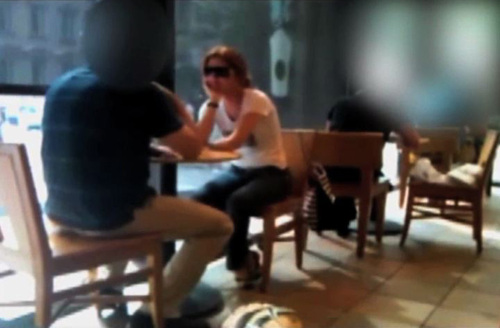 |
This FBI surveillance video shows spy Anna Chapman (wearing sunglasses) in New York. (AP-Yonhap News) |
FBI releases surveillance video on world-famous female spy and her associates
WASHINGTON (AP) -- Anna Chapman wasn’t just a member of one of the largest rings of Russian sleeper agents ever rolled up by the FBI, officials say. The 29-year-old former real estate agent, who became a lingerie model and corporate spokeswoman back in Moscow, represented a new breed of Russian spies adapted to the post-Cold War world.
Chapman and fellow ring member Mikhail Semenko, another young deep-cover agent who worked in a D.C.-area travel agency, were technically skilled, able to work comfortably in a Western culture and did so using their own names, said C. Frank Figliuzzi, FBI assistant director for counterintelligence.
They “were very tech savvy, very intellectual,” Figliuzzi said, adding that Semenko is fluent in five languages including Chinese.
Both of the new-breed operatives used state-of-the-art wireless computer communications, including burst transmitters that sent encrypted messages by radio in a fraction of a second.
Meanwhile, the older spies in the 11-member ring fell back on techniques that have been used for centuries: invisible ink, handoffs of money called “brush passes,” and forged documents. Like Soviet sleeper agents before them, they worked under false identities, called legends, some of them stolen from dead people.
All the veteran operatives had undergone years of intensive training in Russia to pass as ordinary Americans. But with the fall of the Iron Curtain and with open borders, someone in Moscow seems to have realized that training may no longer be necessary.
With the two different approaches, one time tested and one state of the art, “the Russians were experimenting,” said Figliuzzi.
Figliuzzi’s comments came Monday as the FBI released tapes, video and documents that offered a window into the bureau’s surveillance, which stretched over about a decade.
According to a written surveillance report, an FBI agent watched Chapman buy leggings and hats at Macy’s. Later, cameras caught her roaming a department store while a Russian diplomat waited outside.
A surveillance video taken the day before her arrest shows Chapman sitting in a coffee shop with an FBI agent posing as her Russian handler.
Other ring members were shadowed during meetings by a pay phone in the New York City borough of Queens, in a Brooklyn park or during a stroll around New York’s Columbus Circle. The FBI says seemingly mundane pursuits often served as cover for the exchange of encrypted messages or the transfer of cash, all with the long-range goal of penetrating the highest levels of U.S. policymaking.
The FBI watched the ring operate so intensively for so long, Figliuzzi said, that the bureau was able to penetrate the ring’s communications network to the point where U.S. agents were able to pose as Russian intelligence officers.
“So in a sense we began to own their communications,” and Chapman and Semenko came to believe that the undercover FBI agents were their Russian handlers.
The FBI released the material to the Associated Press in response to a Freedom of Information Act request. The investigation was code-named “Ghost Stories,” the release of documents on the Halloween holiday a coincidence. While the deep-cover agents didn’t steal any secrets, an FBI counterintelligence official told the AP that the spies were making progress to their ultimate goal. They “were getting very close to penetrating U.S. policymaking circles” through a friend of a Cabinet official, Figliuzzi said.
He did not name names, but Russian spy Cynthia Murphy of Montclair, New Jersey, provided financial planning for venture capitalist Alan Patricof, a political fundraiser with close ties to Bill and Hillary Rodham Clinton.
The linchpin in cracking the case, apparently, was Col. Alexander Poteyev, a highly placed U.S. mole in Russian foreign intelligence, who betrayed the spy ring even as he ran it.
He abruptly fled Moscow just days before the FBI rolled up the U.S. spy ring operation. Poteyev’s role emerged when a Russian military court convicted him in absentia for high treason and desertion. The FBI did not comment on the Poteyev case.
Called “illegals” because they took civilian jobs instead of operating with diplomatic immunity inside Russian embassies and military missions, the spies settled into quiet lives in middle-class neighborhoods and set about trying to network their way into the worlds of finance, technology and government.
What appears to be a family photo of one spy, Donald Heathfield of Cambridge, Massachusetts, shows him graduating from Harvard’s John F. Kennedy School of Government in 2000. The school revoked the degree a month after the FBI rolled up the spy ring.
The operation’s codename, Ghost Stories, stems from a number of the spies using a technique known among counter-intelligence investigators as “dead doubles” -- taking the identities of people who have died. Tracey Lee Ann Foley, Michael Zottoli, Donald Heathfield and Patricia Mills all used the technique, Figliuzzi said.
The U.S. traded the 10 Ghost Stories spies arrested by federal agents for four Russians imprisoned for spying for the West at a remote corner of a Vienna airport on July 9, in a scene reminiscent of the carefully choreographed exchange of spies at Berlin’s Glienicke Bridge during the Cold War.
While freed Soviet spies typically have kept a low profile after their return to Moscow, Chapman became a model, corporate spokeswoman and television personality. Heathfield, whose real name is Andrey Bezrukov, lists himself as an adviser to the president of a major Russian oil company on his LinkedIn account.
Russian President Dmitry Medvedev awarded the 10 freed spies Russia’s highest honors at a Kremlin ceremony. The case was brought to a swift conclusion before it could complicate President Barack Obama’s campaign to “reset” American relations with the Kremlin, strained by years of tensions over U.S. foreign policy and the 2008 Russian-Georgian war.
All 10 of the captured spies were charged with failing to register as foreign agents.





![[Weekender] Korea's traditional sauce culture gains global recognition](http://res.heraldm.com/phpwas/restmb_idxmake.php?idx=644&simg=/content/image/2024/11/21/20241121050153_0.jpg)


